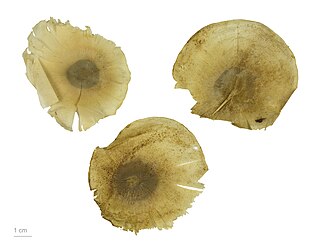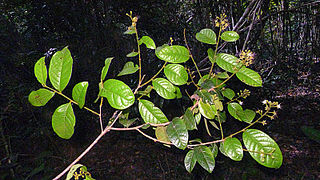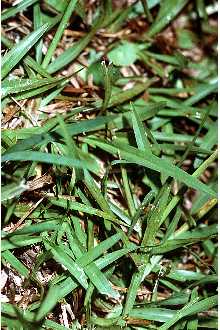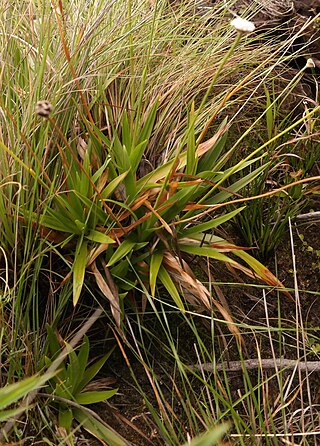
Mandevilla is a genus of tropical and subtropical flowering vines belonging to the family Apocynaceae. It was first described as a genus in 1840. A common name is rocktrumpet.

Pouteria is a genus of flowering trees in the gutta-percha family, Sapotaceae. The genus is widespread throughout the tropical Americas, with outlier species in Cameroon and Malesia. It includes the canistel, the mamey sapote, and the lucuma. Commonly, this genus is known as pouteria trees, or in some cases, eggfruits.

Vriesea is a genus of flowering plants in the botanical family Bromeliaceae, subfamily Tillandsioideae. The genus name is for Willem Hendrik de Vriese, Dutch botanist, physician (1806–1862). Its species are widespread over Mexico, Central America, South America and the West Indies.

Couratari is a genus of trees in the family Lecythidaceae, first described as a genus in 1775. They are native to tropical South America and Central America.

Aspidosperma is a genus of flowering plant in the family Apocynaceae, first described as a genus in 1824. It is native to South America, Central America, southern Mexico, and the West Indies.

Pitcairnia is a genus of plants in the family Bromeliaceae, subfamily Pitcairnioideae. It was named for William Pitcairn, Scottish physician and gardener (1711–1791). The genus Pitcairnia ranks as the second most prolific of the bromeliad family. They are most abundant in Colombia, Peru and Brazil, but can also be found in areas from Cuba and Mexico south to Argentina. One species, Pitcairnia feliciana, is found in tropical West Africa and is the only member of the family Bromeliaceae not native to the Americas.

Aegiphila is a genus of flowering plants in the mint family, Lamiaceae, first described in 1763. It was formerly classified in the Verbenaceae. It is native to Mexico, Central America, South America, the West Indies, and Florida.

Hirtella is a genus of 110 species of woody trees in family Chrysobalanaceae. It was first described as a genus by Linnaeus in 1753. Hirtella naturally occurs in tropical forests throughout Latin America, the West Indies, southeast Africa, and Madagascar. The flowers are mainly pollinated by butterflies.

Axonopus is a genus of plants in the grass family, known generally as carpet grass. They are native primarily to the tropical and subtropical regions of the Americas with one species in tropical Africa and another on Easter Island. They are sometimes rhizomatous and many are tolerant of periodic submersion.

Olyra is a genus of tropical bamboos in the grass family. It is native primarily to the Western Hemisphere, with one species extending into Africa.
Otachyrium is a genus of South American plants in the grass family.

Actinocephalus is a genus of plants in the Eriocaulaceae, first described in 2004. The entire genus is endemic to Brazil. It was formerly regarded as part of the related genus Paepalanthus, but recent studies have suggested that the two groups are better separated.
Comanthera is a genus of plants in the Eriocaulaceae. It is native to tropical South America.
Leiothrix is a genus of plants in the Eriocaulaceae. It is native to tropical South America.
- Leiothrix affinisSilveira - Minas Gerais
- Leiothrix amazonicaMoldenke - Pará
- Leiothrix angustifolia(Körn.) Ruhland - Bahia
- Leiothrix araxaensisSilveira - Minas Gerais
- Leiothrix arechavaletae(Körn.) Ruhland - Uruguay
- Leiothrix argenteaSilveira - Minas Gerais
- Leiothrix argyrodermaRuhland - southeastern Brazil
- Leiothrix arrectaRuhland - Minas Gerais
- Leiothrix barreirensisSilveira - Minas Gerais
- Leiothrix beckii(Szyszyl. ex Wawra) Ruhland - Minas Gerais, Rio de Janeiro
- Leiothrix celiaeMoldenke - Cerro Yutajé in Amazonas State of Venezuela
- Leiothrix cipoensisGiul - Minas Gerais
- Leiothrix crassifolia(Bong.) Ruhland - Minas Gerais
- Leiothrix curvifolia(Bong.) Ruhland - Minas Gerais
- Leiothrix cuscutoidesSilveira - Minas Gerais
- Leiothrix dielsiiRuhland - southeastern Brazil
- Leiothrix distichocladaHerzog - Bahia
- Leiothrix dubiaSilveira - Minas Gerais
- Leiothrix echinocephalaRuhland - Minas Gerais
- Leiothrix edwalliiSilveira - São Paulo
- Leiothrix flagellaris(Guill.) Ruhland - Minas Gerais
- Leiothrix flavescens(Bong.) Ruhland - Guyana, Venezuela, Brazil, Peru, Bolivia
- Leiothrix flexuosaSilveira - Minas Gerais
- Leiothrix fluitans(Mart. ex Körn.) Ruhland - Minas Gerais
- Leiothrix fluminensisRuhland - Rio de Janeiro
- Leiothrix fulgidaRuhland - Minas Gerais
- Leiothrix glanduliferaSilveira - Minas Gerais
- Leiothrix glaucaSilveira - Minas Gerais
- Leiothrix gomesiiSilveira - Minas Gerais
- Leiothrix gounelleanaBeauverd - Minas Gerais
- Leiothrix graminea(Bong.) Ruhland - Minas Gerais
- Leiothrix hatschbachiiMoldenke - Minas Gerais
- Leiothrix heterophyllaSilveira - Minas Gerais
- Leiothrix hirsuta(Wikstr.) Ruhland - eastern Brazil
- Leiothrix itacambirensisSilveira - Minas Gerais
- Leiothrix laniferaSilveira - Minas Gerais
- Leiothrix linearisSilveira - Minas Gerais
- Leiothrix longipesSilveira - Minas Gerais
- Leiothrix luxurians(Körn.) Ruhland - Minas Gerais
- Leiothrix mendesiiMoldenke - Minas Gerais
- Leiothrix michaeliiSilveira - Minas Gerais
- Leiothrix milho-verdensisSilveira - Minas Gerais
- Leiothrix mucronata(Bong.) Ruhland - Minas Gerais
- Leiothrix nubigena(Kunth) Ruhland - Minas Gerais
- Leiothrix obtusifoliaSilveira - Minas Gerais
- Leiothrix pedunculosaRuhland - Minas Gerais, São Paulo
- Leiothrix pilulifera(Körn.) Ruhland - eastern Brazil
- Leiothrix prolifera(Bong.) Ruhland - Minas Gerais
- Leiothrix propinqua(Körn.) Ruhland - Minas Gerais
- Leiothrix retrorsaSilveira - Minas Gerais
- Leiothrix rufula(A.St.-Hil.) Ruhland - eastern Brazil
- Leiothrix rupestrisGiul - Minas Gerais
- Leiothrix schlechtendalii(Körn.) Ruhland - Bahia
- Leiothrix sclerophyllaSilveira - Minas Gerais
- Leiothrix sinuosaGiul - Minas Gerais
- Leiothrix spergulaRuhland - Minas Gerais
- Leiothrix spiralis(Bong.) Ruhland - Minas Gerais
- Leiothrix subulataSilveira - Minas Gerais
- Leiothrix tenuifoliaSilveira - Minas Gerais
- Leiothrix tinguensisHerzog - Bahia
- Leiothrix triangularisSilveira - Minas Gerais
- Leiothrix trichopusSilveira - Minas Gerais
- Leiothrix trifidaSilveira - Minas Gerais
- Leiothrix vivipara(Bong.) Ruhland - Minas Gerais

Mesanthemum is a genus of flowering plants in the family Eriocaulaceae, first described in 1856. It is native to tropical Africa and Madagascar.
Rondonanthus is a genus of flowering plants in the family Eriocaulaceae. It is endemic to northern South America.

Odontadenia is a genus of plant in the family Apocynaceae, first described as a genus in 1841. It is native to southern Mexico, Central America, South America, and the West Indies.
- Odontadenia anomala(Van Heurck & Müll.Arg.) J.F.Macbr. - Peru, Bolivia
- Odontadenia campanulataJ.F.Morales - Colombia
- Odontadenia funigeraWoodson - Venezuela, Colombia, Ecuador, Peru, Brazil
- Odontadenia geminata(Hoffmanns. ex Roem. & Schult.) Müll.Arg. - 3 Guianas, Venezuela, Colombia, Ecuador, Peru, Bolivia, N Brazil
- Odontadenia glaucaWoodson - Amazonas State in S Venezuela
- Odontadenia gracilipes(Stadelm.) Woodson - Minas Gerais
- Odontadenia hypoglauca(Stadelm.) Müll.Arg. - Bolivia, Brazil
- Odontadenia killipiiWoodson - French Guiana, Venezuela, Colombia, Ecuador, Peru, N Brazil
- Odontadenia kochiiPilg. - Guyana, Venezuela, Colombia, Ecuador, Peru, N Brazil
- Odontadenia laxiflora(Rusby) Woodson - Peru, Bolivia, N Brazil
- Odontadenia lutea(Vell.) Markgr. - Peru, Bolivia, Brazil
- Odontadenia macrantha(Roem. & Schult.) Markgr. - Oaxaca, Chiapas, Central America, Trinidad & Tobago, 3 Guianas, Venezuela, Colombia, Ecuador, Peru, Brazil
- Odontadenia markgrafianaJ.F.Morales - French Guiana, N Brazil
- Odontadenia matogrossanaJ.F.Morales - Goiás, Mato Grosso
- Odontadenia nitida(Vahl) Müll.Arg. - Trinidad & Tobago, 3 Guianas, Venezuela, Colombia, Ecuador, Peru, Brazil, Bolivia
- Odontadenia perrottetii(A.DC.) Woodson - Venezuela, Colombia, Brazil, Bolivia, Guyana, French Guiana
- Odontadenia polyneura(Urb.) Woodson - Hispaniola
- Odontadenia puncticulosa(Rich.) Pulle - Central America, 3 Guianas, Venezuela, Colombia, Ecuador, Peru, Brazil, Bolivia
- Odontadenia stemmadeniifoliaWoodson - Venezuela, Colombia, Ecuador, Peru, Brazil
- Odontadenia verrucosa(Willd. ex Roem. & Schult.) K.Schum. ex Markgr. - 3 Guianas, Venezuela, Colombia, Ecuador, Peru, Brazil, Bolivia, Panama, Costa Rica, Nicaragua
- Odontadenia cuspidataRusby = Mandevilla cuspidata(Rusby) Woodson
- Odontadenia duckeiMarkgr. = Mandevilla pohliana(Stadelm.) A.H.Gentry
- Odontadenia glandulosa(Ruiz & Pav.) K.Schum. = Mandevilla glandulosa(Ruiz & Pav.) Woodson
- Odontadenia macrocalyx(Müll.Arg.) Miers = Tabernaemontana macrocalyxMüll.Arg.













